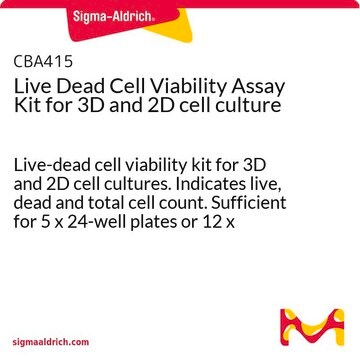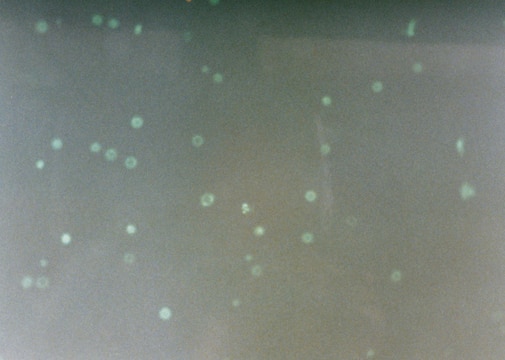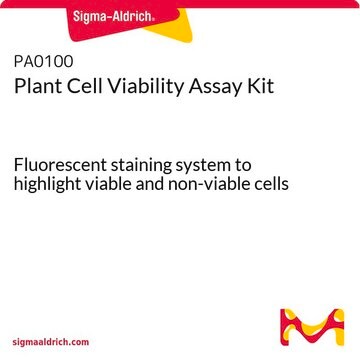04511
Live/Dead Cell Double Staining Kit
suitable for fluorescence
Synonym(s):
Staining kit for live/dead cells
Sign Into View Organizational & Contract Pricing
All Photos(1)
About This Item
UNSPSC Code:
12161503
NACRES:
NA.32
Recommended Products
Application
The Live/Dead Cell Double Staining Kit is utilized for simultaneous fluorescence staining of viable and dead cells. This kit contains calcein-AM and propidium iodide (PI) solutions, which stain viable and dead cells, respectively. Calcein-AM, acetoxymethyl ester of calcein, is highly lipophilic and cell membrane permeable. Though calcein-AM itself is not a fluorescent molecule, the calcein generated from Calcein-AM by esterase in a viable cell emits a strong green fluorescence (λex 490 nm, λem 515 nm). Therefore, calcein-AM only stains viable cells. Alternatively, the nuclei staining dye PI cannot pass through a viable cell membrane. It reaches the nucleus by passing through disordered areas of dead cell membrane, and intercalates with the DNA double helix of the cell to emit red fluorescence (λex 535 nm, λem 617 nm). Since both calcein and PI-DNA can be excited with 490 nm light, simultaneous monitoring of viable and dead cells is possible with a fluorescence microscope. Using λex 545 nm, only dead cells can be observed.
Kit Components Only
Product No.
Description
- Solution A (Calcein AM solution) 4 × 50
- Solution B (propidium iodide solution) 300 μL
related product
Product No.
Description
Pricing
Storage Class
10 - Combustible liquids
wgk_germany
WGK 2
flash_point_f
185.0 °F - closed cup
flash_point_c
85 °C - closed cup
Choose from one of the most recent versions:
Already Own This Product?
Find documentation for the products that you have recently purchased in the Document Library.
Customers Also Viewed
T Kimura et al.
Neuroscience letters, 208(1), 53-56 (1996-04-12)
The recent immunological demonstration of advanced glycation end products (AGE) of the Maillard reaction in several human tissues suggests a possible involvement of AGE in the aging process. We previously prepared a monoclonal anti-AGE antibody (6D12) which recognized N epsilon-(carboxymethyl)lysine.
Amin Hassanzadeh-Barforoushi et al.
Lab on a chip, 18(15), 2156-2166 (2018-06-21)
We present here a new method to easily and reliably generate an array of hundreds of dispersed nanoliter-volume semi-droplets for single-cells culture and analysis. The liquid segmentation step occurs directly in indexed traps by a tweezer-like mechanism and is stabilized
Camille Raillon et al.
Cytometry. Part A : the journal of the International Society for Analytical Cytology, 95(10), 1085-1095 (2019-08-01)
The isolation, analysis, and enumeration of circulating tumor cells (CTCs) from cancer patient blood samples are a paradigm shift for cancer patient diagnosis, prognosis, and treatment monitoring. Most methods used to isolate and enumerate these target cells rely on the
Carolina Fracalossi Rediguieri et al.
Journal of biomaterials science. Polymer edition, 28(16), 1918-1934 (2017-07-25)
The growing area of tissue engineering has the potential to alleviate the shortage of tissues and organs for transplantation, and electrospun biomaterial scaffolds are extremely promising devices for translating engineered tissues into a clinical setting. However, to be utilized in
Rossella Barenghi et al.
BioMed research international, 2014, 624645-624645 (2014-11-19)
One of the main open issues in modern vascular surgery is the nonbiodegradability of implants used for stent interventions, which can lead to small caliber-related thrombosis and neointimal hyperplasia. Some new, resorbable polymeric materials have been proposed to substitute traditional
Articles
Cell based assays for cell proliferation (BrdU, MTT, WST1), cell viability and cytotoxicity experiments for applications in cancer, neuroscience and stem cell research.
Our team of scientists has experience in all areas of research including Life Science, Material Science, Chemical Synthesis, Chromatography, Analytical and many others.
Contact Technical Service










